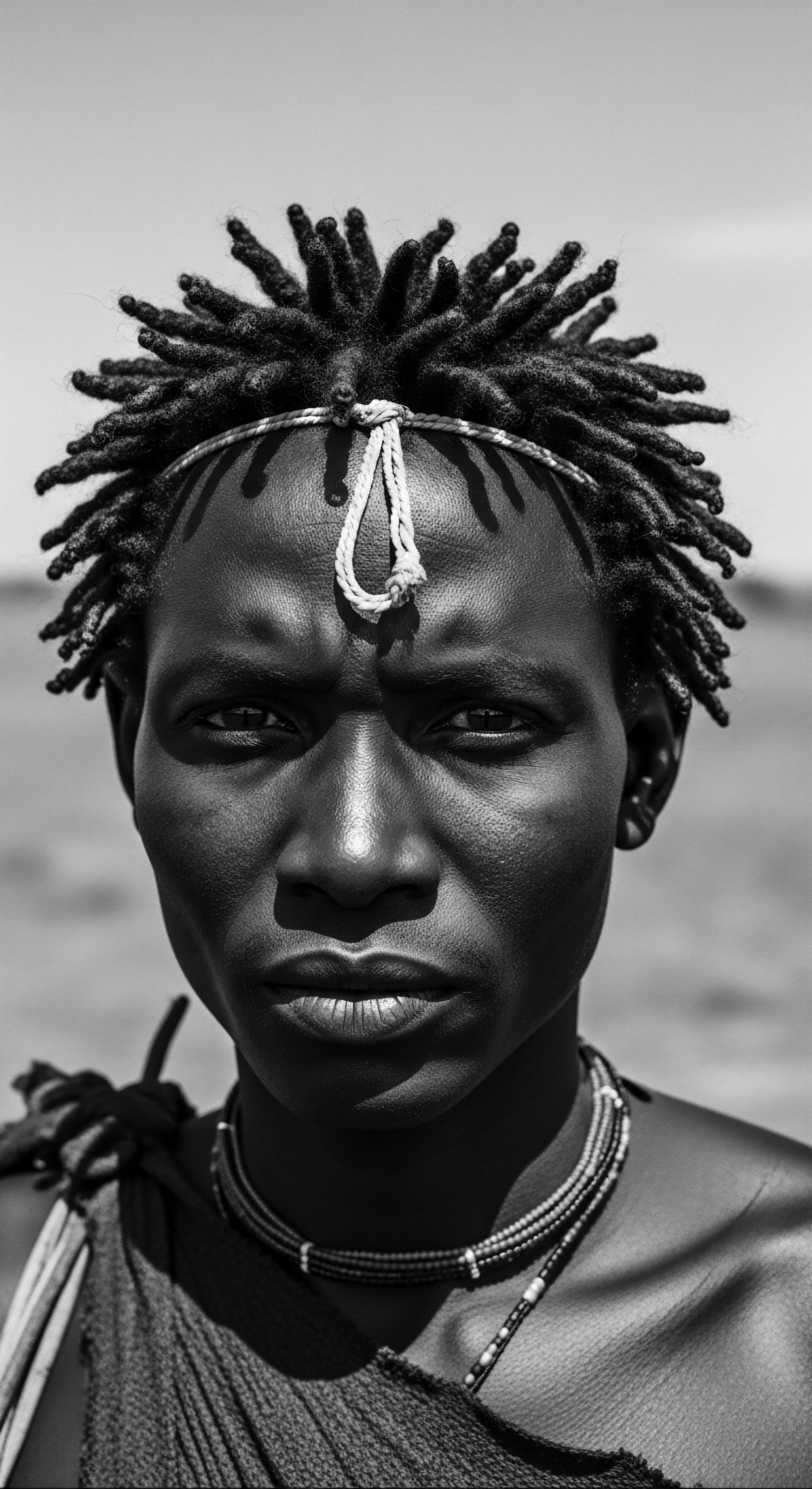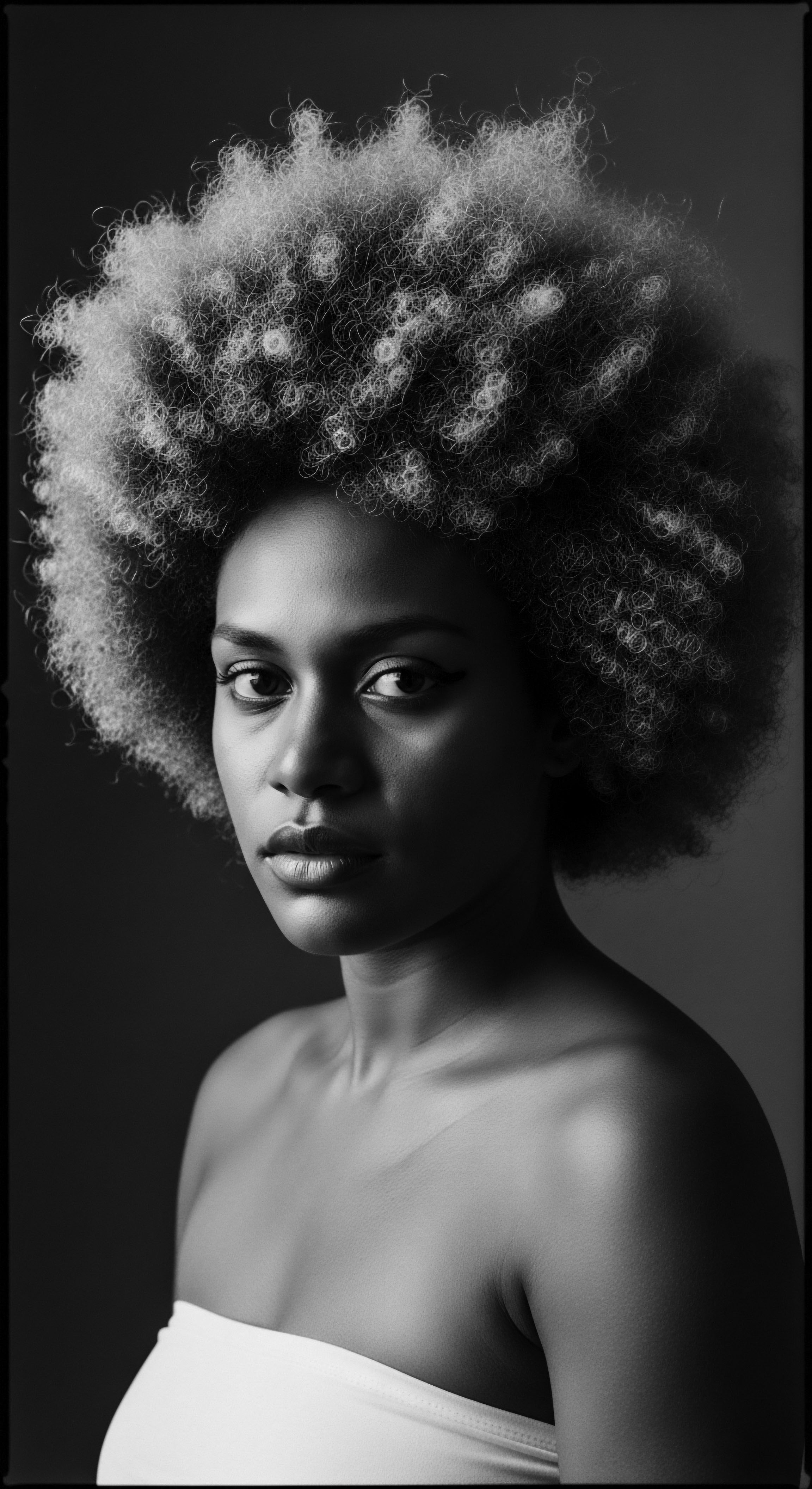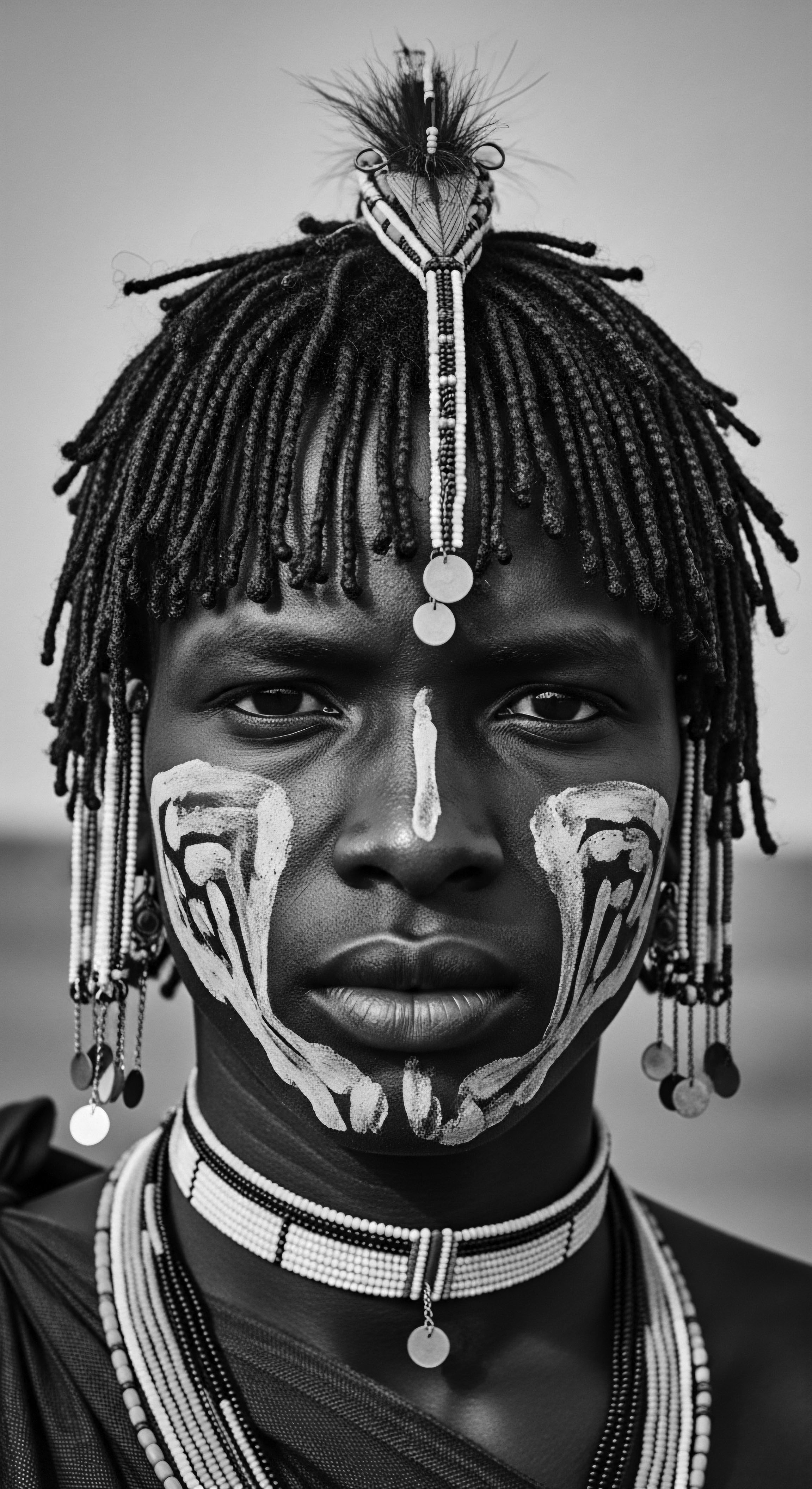
Fundamentals
The concept of Internal Nourishment, at its foundation, describes the deep sustenance of our physical and inner selves, stemming from within. It speaks to how the sustenance we take in, the thoughts we hold, and the energy we carry, all contribute to our complete well-being. For textured hair, especially within Black and mixed-race communities, this is a particularly potent idea. It extends beyond surface-level conditioners and balms to consider the body’s entire system.
The hair, as a living fiber, reflects the state of our inner ecology. When we speak of Internal Nourishment for these hair types, we acknowledge a wisdom that has long understood the body as an interconnected system.
Historically, communities with rich textured hair heritages understood this connection inherently. They saw hair not as a separate entity, but as an outward indication of the body’s health, a barometer of inner vitality. This basic understanding forms the earliest layer of meaning for Internal Nourishment.
It suggests that true hair health begins not with what is applied, but with what is present within. This is a simple, yet powerful, notion that grounds our care in ancestral practices and bodily wisdom.
Internal Nourishment for textured hair concerns the deep sustenance of our physical and inner selves, reflecting an understanding that hair vitality begins within.

Roots of Well-Being
Our hair, with its unique bends and spirals, draws its strength from the very nutrients coursing through our blood. This basic biological truth forms the elemental aspect of Internal Nourishment. It involves the careful balance of essential compounds that support cellular growth, repair, and ongoing function. Every strand begins its formation deep within the scalp, within the hair follicle, where a steady supply of these building blocks becomes essential for robust growth.
Across generations, traditional systems of care recognized this dependence. They understood that what a person consumed directly affected the strength and luster of their hair. The choice of foods, the preparation methods, and the communal act of sharing meals all played roles in ensuring this internal support.
This foundational aspect of sustenance, taken in and utilized by the body, directly shapes the hair’s ability to resist breakage, maintain its structure, and retain its characteristic moisture. It provides the core materials.

Intermediate
Moving beyond its elemental meaning, Internal Nourishment gains depth as an explanation of the continuous dialogue between our inner metabolic processes and the visible health of textured hair. This intermediate understanding moves from simple intake to the complex ways the body uses these resources, extending to the mental and emotional states that also govern our physical expressions. Hair, particularly hair with tight curls or coily structures, demands significant internal resources for its creation and maintenance. Its unique architecture makes it more prone to dryness and breakage without sufficient inner support.
For descendants of African and mixed-race lineages, this understanding has always held cultural weight. Hair was, and remains, a sacred outward expression, and its health was often a mirror to the collective health and circumstances of a community. The care rituals passed down through families speak to an awareness that extended beyond mere styling. These rituals often combined topical applications with a focus on dietary choices, reflecting an understanding that the external and internal realms of care must align.

The Interconnected Systems
The human body functions as a unified system, where the vitality of one part supports the whole. When we approach Internal Nourishment from this perspective, we consider not only the physical intake of vitamins and minerals but also the subtle energetic exchanges within the body. The circulation of blood, carrying oxygen and nutrients to the scalp, represents a vital component. Insufficient circulation or a lack of specific compounds can hinder the hair follicles’ ability to function optimally, leading to slower growth or weakened strands.
Historically, this interconnectedness was often explained through ancestral wisdom that linked diet, lifestyle, and emotional well-being. For example, traditional African diets were often rich in legumes, leafy greens, and fatty fish—all sources of nutrients recognized today for their contributions to hair health, such as proteins, iron, and omega-3 fatty acids. These food selections were not random; they were part of a deep knowledge system that saw direct correlations between the earth’s bounty and human vitality, including the strength of one’s crown.

Beyond Physical Sustenance
Internal Nourishment also means a care for the mind and spirit, as these aspects profoundly influence physical health. Stress, emotional hardship, or a lack of communal support can manifest in various physical ways, including changes in hair condition. The resilience of textured hair, often a symbol of enduring spirit, is also susceptible to these internal pressures.
- Stress Management ❉ Prolonged periods of stress can disrupt the body’s hormonal balance, influencing hair growth cycles and leading to increased shedding.
- Mindful Practices ❉ Traditional practices, such as meditation or communal singing, served as methods to calm the spirit, creating an inner state conducive to overall well-being, which in turn supported physical vitality.
- Community Support ❉ The strength drawn from collective bonds and shared experiences offered a powerful form of emotional sustenance, fortifying individuals against hardship.
The tender acts of hair grooming within families, where stories were exchanged and wisdom passed on, offered not only physical care but also significant emotional and psychological sustenance. These sessions, rooted in love and connection, directly contributed to the well-being that showed in healthy, vibrant hair.

Academic
Internal Nourishment, from an academic standpoint, represents a comprehensive biological and psychosocial construct, central to the phenotype and resilience of textured hair, particularly within the context of Black and mixed-race heritage. This explanation extends beyond a simple physiological intake of food to encompass the intricate molecular mechanisms, epigenetic influences, and deeply embedded cultural practices that collectively shape the hair fiber from its follicular origin to its visible presentation. It describes a continuum of influence where systemic biological states, modulated by dietary composition, micronutrient availability, and the profound effects of psychosocial well-being, directly determine the structural integrity, growth kinetics, and overall appearance of hair strands.
The meaning of Internal Nourishment gains substantial depth through examining its historical and diasporic implications. Hair cells rank among the body’s most rapidly dividing cells, second only to intestinal cells, making them highly susceptible to internal shifts, including nutritional deficits. This biological sensitivity meant that for enslaved African peoples, where deliberate deprivation of water and food was a tool of control, hair health often served as a somber indicator of extreme duress. However, within this period of forced adaptation, a remarkable instance of resourceful Internal Nourishment stands as a stark testament to the ingenuity and will to survive.
During the traumatic Transatlantic Slave Trade, some African women, facing the eighty-day voyage of immense hardship, would braid rice or other vital grains directly into their hair or their children’s hair. This specific act, a poignant intersection of cultural practice and survival, provided a concealed source of internal sustenance for a journey where food scarcity was a deliberate weapon. This historical example is not merely an anecdote; it serves as a powerful, albeit harrowing, case study in extreme Internal Nourishment, where the body’s essential need for calories and nutrients was met through an ancestral hair styling tradition. This practice, while physically external, was fundamentally about sustaining life and the internal machinery necessary for survival, including the body’s ability to maintain its systems.
The braiding of rice and grains into hair during the Middle Passage exemplifies Internal Nourishment as a stark, profound act of survival and continuity amidst extreme duress.

Biochemical Foundations and Hair Archetypes
The architecture of textured hair, with its unique coiling and varied lipid content, necessitates a robust supply of specific biomolecules. Afro-textured hair, for instance, exhibits the highest overall lipid content, possessing quantities estimated to be 2.5 to 3.2 times greater than European and Asian hair, respectively, including higher internal lipid levels. This composition points to particular requirements for dietary fatty acids and fat-soluble vitamins, which contribute to scalp health and the hair’s inherent moisture barrier. A deficiency in essential amino acids, particularly those rich in sulfur like cysteine (a primary component of keratin, the protein composing hair), can compromise the disulfide bonds that give textured hair its characteristic curl pattern and strength.
Furthermore, specific micronutrients hold considerable weight. Iron, fundamental for oxygen transport to hair follicles, and zinc, which influences hormone regulation pertinent to growth cycles, both play considerable roles. Vitamin D deficiency, notably prevalent among African Americans due to melanin’s impact on UVB absorption, has been connected to various health challenges and potentially impacts hair well-being. This biological reality gives ancestral food systems, often rich in these compounds, a contemporary scientific validation.

The Legacy of Dietary Disruption and Adaptation
The forced migration and subsequent enslavement of African peoples created a catastrophic disruption of traditional dietary patterns, leading to widespread nutritional deficiencies. This shift from nutrient-dense indigenous African diets, which included ample leafy greens, tubers, and diverse protein sources, to the meager, often monotonous rations of the enslaved, directly impacted physical health, including the hair. The resourceful adaptations, such as the use of bacon grease or butter as hair conditioners in periods of extreme scarcity, underscore the desperate attempts to provide some form of ‘nourishment’ externally when internal stores were severely depleted.
The enduring health disparities within the African diaspora, including higher rates of certain conditions, are partly attributable to these historical dietary alterations and their epigenetic echoes across generations. Understanding this historical context provides a deeper appreciation for the modern emphasis on nutrient-rich diets and culturally resonant approaches to hair care.

Hair as a Psychosocial Barometer
The meaning of Internal Nourishment also encompasses the profound psychosocial dimensions of well-being. Hair serves as a potent marker of identity, status, and self-acceptance within Black and mixed-race communities. Societal pressures, historical discrimination (such as texturism favoring straighter hair), and the continuous negotiation of beauty standards have placed considerable psychological stress on individuals with textured hair.
Chronic stress, anxiety, or feelings of inadequacy can trigger physiological responses that directly impair hair health, such as telogen effluvium, a temporary hair loss condition. The connection between mental stress and hair health is well-documented in dermatological literature. Therefore, Internal Nourishment also means fostering mental resilience, cultivating self-love, and engaging in community practices that affirm one’s heritage and natural beauty. The natural hair movement, for example, represents a collective act of psychosocial nourishment, reclaiming identity and promoting self-acceptance through the celebration of hair in its natural state.
The table below provides a concise comparison of traditional African dietary elements and their modern scientific equivalents regarding hair health.
| Traditional Dietary Elements (Heritage) Leafy Greens (e.g. Ugu, Amaranth, various African greens) |
| Contemporary Nutritional Correlation for Hair Rich in Iron, Vitamins A & C; supports hair growth and sebum production. |
| Traditional Dietary Elements (Heritage) Fatty Fish (e.g. Mackerel, Catfish common in African diets) |
| Contemporary Nutritional Correlation for Hair Source of Omega-3 fatty acids; reduces scalp inflammation and improves follicle circulation. |
| Traditional Dietary Elements (Heritage) Legumes & Beans (e.g. Black-eyed Peas, Lentils, Bambara Beans) |
| Contemporary Nutritional Correlation for Hair Excellent plant-based protein for keratin synthesis, contains iron and zinc vital for growth. |
| Traditional Dietary Elements (Heritage) Sweet Potatoes & Carrots (staples in many African diets) |
| Contemporary Nutritional Correlation for Hair High in Vitamin A; crucial for sebum production and scalp moisture. |
| Traditional Dietary Elements (Heritage) This table highlights how ancestral dietary wisdom aligns with current scientific understanding, underscoring the deep heritage of Internal Nourishment. |

Integrated Care and Future Trajectories
The academic approach to Internal Nourishment for textured hair therefore advocates for an integrated model of care. This model recognizes the profound interplay between genetics, internal physiology, and external environmental factors, all interpreted through a heritage lens. It requires careful consideration of individual nutrient status, acknowledging potential historical or genetic predispositions to certain deficiencies, such as vitamin D.
Furthermore, it advocates for therapeutic interventions that consider the psychological load carried by individuals navigating hair discrimination and the ongoing impact of Eurocentric beauty ideals. True Internal Nourishment, from this perspective, demands both biochemical support for the hair follicle and profound validation of the individual’s cultural identity and personal well-being. It is a concept that builds a bridge from ancient practices to contemporary science, affirming the power of heritage in shaping our understanding of wellness.

Reflection on the Heritage of Internal Nourishment
To truly comprehend Internal Nourishment is to walk a path deeply worn by generations, especially within the communities of textured hair. It is a concept that began not in laboratories, but in the rhythm of daily life, in the choices made around communal hearths, and in the solace found within shared moments of care. This enduring wisdom, often passed down through whispered advice and observed practice, formed the early understanding that outward strength and beauty stem from an inner wellspring. The journey of textured hair through history — from the revered ceremonial styles of pre-colonial Africa to the resourceful adaptations under extreme duress of enslavement, and the defiant reclamation of natural forms today — is a living testament to this truth.
Internal Nourishment reminds us that hair is not merely strands of protein. It is a chronicle, a legacy, a living archive. It holds the echoes of what our ancestors ate for vitality, the emotional burdens they carried, and the deep resilience they embodied. To care for textured hair with Internal Nourishment in mind is to honor this unbroken chain of being.
It is an invitation to listen to the body’s subtle signals, to seek sustenance not just in products, but in plate and peace. It asks us to consider the whole person, recognizing that the health of the crown ultimately depends on the health of the soul, a profound and continuous connection across time. This perspective calls for a respectful inquiry, a gentle hand, and an open heart, ensuring that every act of care becomes a continuation of a beautiful, rich heritage.

References
- Byrd, Ayana, and Lori L. Tharps. 2014. Hair Story ❉ Untangling the Roots of Black Hair in America. St. Martin’s Press.
- Cruz, C.F. Fernandes, M.M. Gomes, A.C. Coderch, L. Martí, M. Méndez, S. Gales, L. Azoia, N.G. Shimanovich, U. Cavaco-Paulo, A. 2013. Keratins and lipids in ethnic hair. International Journal of Cosmetic Science, 35(3), 244-249.
- Guo, E.L. and R. Katta. 2017. Diet and hair loss ❉ effects of nutrient deficiency and supplement use. Dermatology Practical & Conceptual, 7(1), 1-10.
- Jablonski, Nina G. and George Chaplin. 2014. Living Color ❉ The Biological and Social Meaning of Skin Color. University of California Press.
- Sadgrove, Nigel J. 2024. Cosmetopoeia of African Plants in Hair Treatment and Care ❉ Topical Nutrition and the Antidiabetic Connection? Diversity, 16(2), 96.
- The Federal Writers’ Project. 1936. “‘Father’ Charles Coates”. Florida Slave Narratives. Jacksonville, Florida.
- Tucker, Ashley. 2022. The Art of Healing ❉ A Nostalgic Ode to Black Hair Braiding. Copyright Office Blog.
- Wong, T.P. and J.M. Kwak. 2021. Hair Aging in Different Races and Ethnicities. Journal of Clinical & Aesthetic Dermatology, 14(1), 32–37.
- Zou, R. et al. 2017. Does the High Prevalence of Vitamin D Deficiency in African Americans Contribute to Health Disparities?. Nutrients, 9(8), 884.
